|
Nikon Coolpix AW100
After a decade, Nikon is back in the business of underwater cameras.
(by Conrad H. Blickenstorfer and Carol Cotton)
If you're a camera historian or a diver who's been around the block a few times, you'll remember the Nikonos underwater camera that was launched in 1963 and sold until 2001. 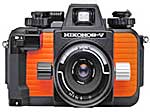 The Nikonos camera was waterproof all by itself and didn't need a housing. Its design went all the way back to Jacques Cousteau, but it was Nikon that owned and improved the camera over several decades (see Evolution of Nikonos). The Nikonos camera was waterproof all by itself and didn't need a housing. Its design went all the way back to Jacques Cousteau, but it was Nikon that owned and improved the camera over several decades (see Evolution of Nikonos).
Given this grand history, it's somewhat of a surprise that Nikon didn't enter the burgeoning market of tough waterproof cameras until last year, August 2011 to be exact, with the Coolpix AW100. While the Coolpix is an entirely different animal, Nikon's designers and engineers must have been aware they were carrying on a tradition for in at least the color scheme, the new underwater Coolpix looks just like the storied Nikonos V. It's available in black and orange. In this article and review, we report on the Coolpix AW100 based on a couple of months' worth of above and underwater experience with the camera.
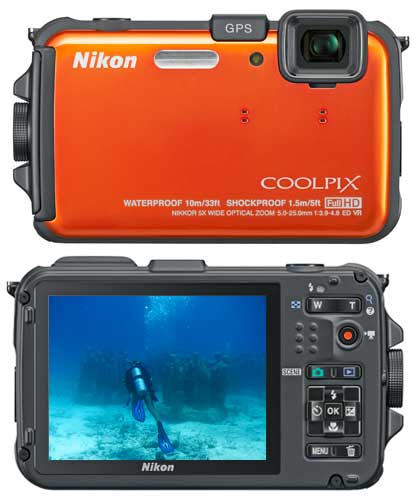
Coolpix AW100: Tough acts to follow
Only Nikon knows the reasons for the decade-long gap between the last Nikonos and the introduction of the AW100. Quite obviously, time hasn't stood still and the ten years since Nikon's departure from underwater cameras have seen a cataclysmic upheaval in photography and all things imaging. Whereas back in 2001 most still thought film would never go away, it's gone now, hundreds of millions have smartphones that can do high-quality, high resolution pictures and even high resolution video better than anything professional equipment could generate back then at almost any cost. And remaining pictures in the camera are no longer counted on the fingers of your hand, but in the thousands.
And the competition hasn't stood still. By 2006 or so, innovative pioneers saw a market for cameras that didn't need to be babied but could be used outdoors, in the rain and even underwater. Some began offering elegant compact cameras that were waterproof, shockproof and freezeproof. In a 2007 review we marveled at being able to take (in clear violation of its 33-feet depth limit) one of those cameras down to 70 feet or below.
As of this writing (Fall 2012), every major camera manufacturer has at least one waterproof camera, and some have several. Among them are ruggedized models that are now in their 4th and 5th generation, and some that are not only waterproof, but also crushproof and freezeproof and shockproof. The obvious question: did Nikon get it right after its long absence from this market. Can the AW100 compete?
What do you get with the Nikon AW100?
One might expect a tough, rugged waterproof camera to be big and hefty and look the part, but while the AW100 is a little heavier and larger than your standard superslim digital camera, it really feels hardly any different from your modern point & shoot. Roughly the size of a smartphone (4.4 x 2.6 inches) but a bit thicker (0.9 inches) and heavier (6.2 ounces), you can easily slip this Coolpix into a pocket and hardly notice it's there.
Technical specs are what you'd expect from a dedicated camera today. This is a 16-megapixel camera with a 5X optical zoom that starts wide at 28mm and goes up to 140mm (35mm equivalent). 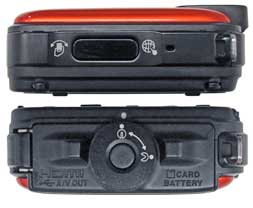 It has 83MB of internal storage, which means there's room for a few pictures even if the SD storage card is full (or if you forget to put a card in), and the AW100 can take full 1080p (1920 x 1080 pixel) HD video, at full 30 frames per second speed. The bright 3-inch display still has the traditional 4:3 aspect ratio, so if you shoot in wide format, pics will be letter-boxed. It has 83MB of internal storage, which means there's room for a few pictures even if the SD storage card is full (or if you forget to put a card in), and the AW100 can take full 1080p (1920 x 1080 pixel) HD video, at full 30 frames per second speed. The bright 3-inch display still has the traditional 4:3 aspect ratio, so if you shoot in wide format, pics will be letter-boxed.
The side views above show a special "Action" button used for the camera's GPS functions and a special rotating security look that guards the I/O, battery and storage card department (all in one) against accidental opening. The top and bottom views below show the prominent shutter, the properly recessed on/off button and the GPS antenna bump on top, and the tripod mount at the bottom.
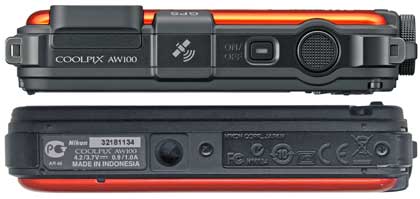
The black plastic body looks competent and businesslike, and feels sturdy enough. The glossy bright orange metal panel in the front sounds a bit hollow when you tap on it. But the toughness specs are quite impressive. The camera is designed to survive 5-foot drops, operate in a wide 14 to 104 degree Fahrenheit temperature range, it's totally dustproof, and it can handle depths down to 33 feet.
Features: plenty enough
There is tremendous pressure on camera manufacturers to both differentiate themselves from the competition and at the same time keep up with them. Over the past several years this meant including numerous operating modes, tricks like face recognition, numerous in-camera edition functions, filters, effects, etc. The AW100 has all that and, to be honest, in our opinion actually almost too much of it. But apparently it all has to be there so that no check boxes remain unchecked, even if that means pet portraits and in-camera tools that no one uses because that's done on the PC.
As is, the camera has an "Easy Auto" mode that automatically picks from portrait (day or night), landscape (day or night), close-up, backlight, or a variety of other scene modes. What's good to know here for divers is that in Easy Auto, the Coolpix will always automatically switch to underwater mode as soon as it is immersed into water.
If you want to select the shooting mode yourself, you can do so from a menu with 19 modes, with some giving you additional options when selected. Alternately, you can select from a number of special effects though, again, much of this can be done in post-processing. Then there's a Smart Portrait Mode where the camera can do tricks like waiting for a smile or avoiding blinks. Finally, there's an Auto mode that allows, in the absence of a manual mode, a degree of control over such things as white balance, ISO, autofocus settings, and shooting mode.
Personally, I'd gladly do without most of the many features, or at least I'd like to see them exchanged for features more in line with the tough and rugged nature of the camera. Multiple underwater settings, rain or fog settings, easy access to different image stabilizations, or some such come to mind.
GPS — complex but rewarding
The Coolpix AW100 has integrated GPS. The camera is designed to receive GPS signals, display the current location on a zoomable map, and record GPS data onto images. It can even display nearby points of interest. This can add a whole new dimension to picture taking.
Problem is, it's all not very intuitive. The GPS setting options only become available after you push a button on the side of the camera; they should simply be part of the settings menu. There is a tiny GPS satellite icon when GPS is on, but it is not obvious that the mere presence of the GPS icon is not enough to actually record GPS data; instead, it must not only be present and active, but it must also receive data from at least three satellites, which is indicated by a different GPS icon.
To view GPS information, you need to use the ViewNX2 software that comes with the camera. Or you can view a map both in shooting mode or in playback mode if the proper satellite reception is present.
We finally did get the GPS setup to run and show us our location. But once out to sea, it was not possible to pan and see where we were; you could only zoom in or out, which was in big increments.
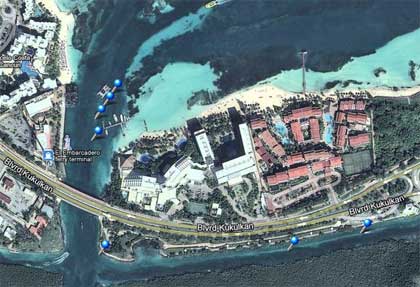
In all fairness, once you made the effort to figure out how it all works, with a bit of luck you end up with a collection of pictures that contain enough GPS data so that you can view the exact location where each picture was taken, including the direction. The precision is quite amazing. You can also log data as you're moving about and then see on the map in ViewNX2 exactly where you traveled. The screen capture below shows the log of one of our ocean excursions.
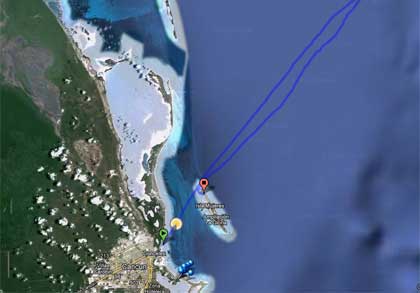
GPS is a very useful addition to the AW100. It's not easy to figure out and put to best use. But if you do take the time to learn it all, it really elevates shooting adventure pictures to a whole new level.
Power
The Coolpix AW100 uses a 1,050 mAh, 3.7V Li-Ion Nikon EN-EL12 battery. A full charge is good for about 250 pictures or 95 minutes of 1080p movie recording, though that depends on how often you use the LCD and how bright you set it. Replacement batteries are inexpensive and widely available, so I'd get a spare or two. The AW100 comes with an external charger for the battery with a six-foot power cord. We'd prefer a charger that plugs directly into the wall so you don't have to take a cable along.
Nikon Coolpix AW100 in the Sea of Cortez
Thanks to Nikon's ever helpful PR team, we had a chance to take a Coolpix AW100 along on a 7-day dive and exploration trip through the Midriff islands of the Sea of Cortez aboard the good ship Rocio Del Mar. We felt that was a great way to see how well the tough Coolpix performs under the often demanding conditions on a scuba diver live-aboard. Below is the 110-foot Rocio Del Mar, our home for an awesome week of diving, snorkeling and photography. Note that all pictures in this review (except for the ones with the Coolpix in it) were taken with the AW100.
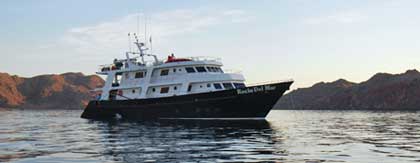
Though we encountered some problems, the Coolpix turned out to be a handy companion for this type of salty, wet and occasionally wild exploring. Our plan was to use the AW100 as it was intended to be used, in the sand, on beaches, swimming, snorkeling, and even for diving.

The Sea of Cortez itself (which the Mexican government officially renamed the Gulf of California) is about 800 miles long, between 30 and 150 miles wide, and has an average depth of almost 2,700 feet. Also known as the Islas Grandes, the eleven Midriff islands are located in the upper third of the Sea of Cortez. All are uninhabited and there's a haunting, stark beauty to them.
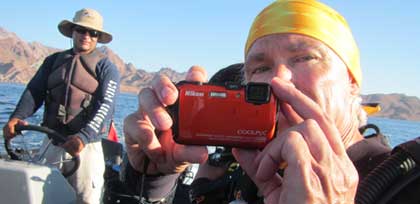
Due to currents, diving was off inflatables. So it was a good thing that the Coolpix AW100 is completely waterproof. That's good, and the 33-foot depth rating means the Coolpix can be used for actual diving. That, however, is still just borderline for actual scuba diving as most dives are deeper. There are some shallow reefs in the 25 to 40 foot range, but even if you assume a 33-foot rated camera can go a bit deeper, you don't want to risk flooding it, and so we only took the AW100 on a few actual dives. And on one of them, some of the hardware control buttons became inoperable due to the water pressure.
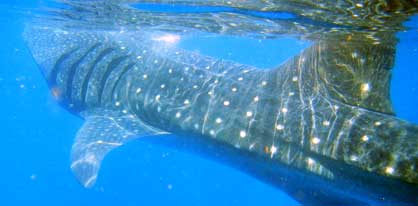
In the Sea of Cortez, we had more luck with the Coolpix when snorkeling. For example, we took it along swimming and snorkeling with whale sharks in the Bahia de los Angeles, a coastal bay on the eastern shore of Baja California. The almost fully enclosed bay is part of a biosphere reserve, and we came here to see whale sharks. Whale sharks are filter feeders and the largest living fish on the planet. They can be over 40 feet in length, weigh almost 40 tons, and go back some 60 million years. They pose no danger to divers and snorkelers, and they can be observed as they are slow swimmers. The picture above was taken with the Coolpix AW100, and we also took 1080p HD video of the whale sharks.
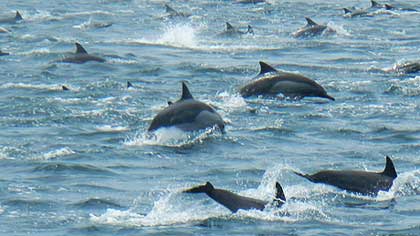
The Coolpix was perfect having around the boat because it is so small and handy, and because we obviously never had to worry about it getting wet. As a result, we managed to get a number of great shots of bottlenose dolphins when they suddenly appeared out of nowhere.
Nikon Coolpix AW100 in Cancun/Isla Mujeres
We got some great pictures and video off the Coolpix in the Sea of Cortez, but the problem we had with the non-functioning control buttons on a 20-30 foot dive had us concerned. We brought it to Nikon's attention, but didn't hear back on the issue. Nikon was, however, nice enough to extend the loan so that we could take it on another product review trip, to give it another chance underwater. Taking beauty shots of the spectacular Riu Palace Resort in Cancun (that's its pool below), of course, was not a challenge for the competent and businesslike Coolpix.
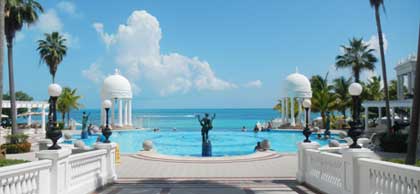
But then we took it on another dive, this one to the world-famous MUSA underwater museum off Isla Mujeres. There, we took pics and lots of video of the over 400 statues sitting at the bottom of the sea, albeit at depths of just 20 to 30 feet.
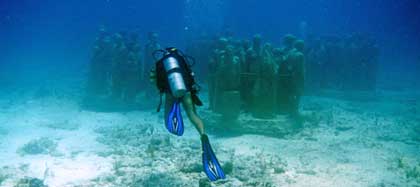
This time we didn't have any problems with the buttons. The diving conditions were quite different, with much more light, less depth, and much warmer water. This meant that we simply pushed the shutter or video button instead of trying to mess with settings in the murkier waters in the Sea of Cortez. The picture below shows some of the spectacular corals and sea fans in the shallow reefs off Isla Mujeres.
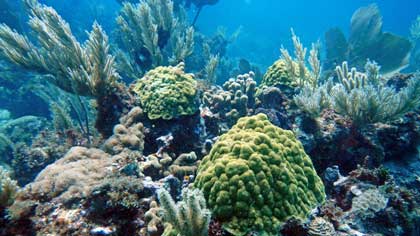
Isla Mujeres also so happens to be one of the world's greatest places to see whale sharks, and so we took a boat out into the open sea and found a large number of sharks to snorkel with. The picture below is a screen snap from one of the Coolpix videos we took of the sharks.
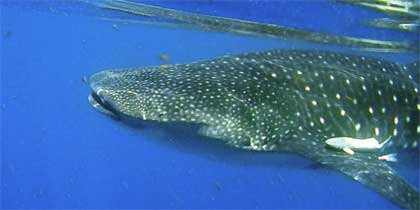
How well did Nikon do with the Coolpix AW100?
Given Nikon's long absence from the rugged/waterproof camera market, how well did the Coolpix AW100 hit the mark?
On the plus side...
- (Almost) a real dive camera. Most waterproof cameras in the AW100's class share its 10 meters or 33-feet depth limit. That means you can take it on dives, but only when you know the dive site and know it won't get much deeper. Else, you might find yourself separated from the group, which is never a good thing. There are some competitors that can go a bit deeper. We had the Pentax WG-2 down to 50 feet, for example (it's rated 40 feet), and that made it much more of a dive camera.
- Truly tough. The Coolpix AW100 really looks hardly tougher than your average point & shoot, but it is. The camera can handle 5-foot drops. Though no one means to drop a camera, it happens, and especially out there in the field. It's good to know the Coolpix can handle it. We also like the wide operating temperature range, which is likely even wider than Nikon specifies as I'm pretty sure it can take pictures past its 104 degree Fahrenheit maximum.
- Folding 5X zoom. You don't really need zoom underwater, but above water a full 5x optical zoom is just so much nicer than only a standard 3x. It is also very helpful, both on land and underwater, that the zoom starts wide at 28mm, which comes in handy in cramped spaces.
- Quality pictures. We also expect good picture quality from Nikon, and in general we got them. But you need to get to know this camera to really make it shine. Without that and just letting the camera pick its own settings often resulted in over saturation above water and under saturation below.
- HD video and video modes. The AW100 can shoot in full 1080p 30fps video, as well as 720p at 30 or 60fps. There are also iFrame 540, VGA and QVGA modes, and in some you can record up to 240 frames per second for slow motion video.
- Bright LCD. The bright 3.0-inch hi-res display with its anti-reflection coating and wide viewing angle is a good choice for an outdoor and underwater camera.
- Build quality. The AW100 is light, but tougher than it looks. After several weeks of hard use, there were no scratches, dents or dings.
- Underwater shooting mode. As you'd expect, the camera has an underwater shooting mode that corrects color in underwater conditions.
- Quick and handy. The camera locks onto subjects quickly. This is important underwater where things (and the diver) tend to move around a lot. Switching between normal and macro modes was quick and easy, and so was switching between flash modes.
- GPS. IF you take the time to figure out the AW100's integrated GPS and get over some of its quirks, it can be very useful and a lot of fun.
Things we weren't so crazy about...
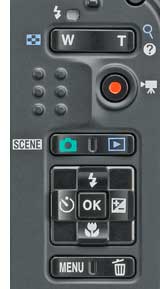 - Small buttons. The good news is that all buttons are in a very standard layout. But for an outdoor/underwater camera, the buttons are very small. Some of the buttons became inoperable at depths of less than 20 feet. That's bad news when the camera is stuck in some mode while diving.
- Features choice. The Coolpix has tons of features and functions, but considering that it's a tough outdoors camera, we'd expect functions to match, not the same playful lineup you'd find in every consumer digicam. For example, while the camera is certainly quite tough, it has only a single underwater mode for stills, none for video, and no obvious way to adjust underwater white balance. We'd like to see features that better match the tough outdoors nature of this camera.
- We did notice considerable softness in 1080p video, especially underwater.
- No housing available. For deeper dives, some of the competition offers an optional deepwater case. None is available for the Coolpix AW100 from Nikon.
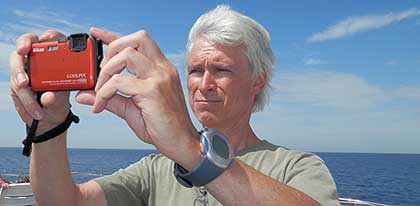
Bottom line: Nikon Coolpix AW100
The Coolpix AW100 is Nikon's first waterproof camera since the fabled line of Nikonos film cameras that last sold a decade ago. With the waterproof/outdoor niche now having become almost mainstream with offerings by Canon, Nikon, Panasonic, Fujifilm and a number of specialty manufacturers, Nikon is back with a 16-megapixel camera that's as tough as it gets in this class, and equipped to handle whatever abuse it may encounter outdoors. It can be used in freezing weather (down to 14 degrees Fahrenheit), it is dust and waterproof, and it can handle being dropped from up to five feet.
Divers can take it down to 33 feet of depth (though we had some problems operating buttons well above that limit), enough for shallow reef dives. The camera's controls are quite small and we'd like simpler operation underwater. We were impressed, though, with overall color accuracy, vibrance, and sharpness.
720p and 1080p high definition video modes, at full 30fps speed, greatly add to the usefulness of this camera, but we'd like to see more underwater modes and also manual underwater white balance settings and adjustments.
The AW100 has a bright and vibrant 3.0-inch LCD display with anti-reflection treatment. The 28-140mm equivalent 5X optical zoom works great underwater where wide angle shooting is almost mandatory. The GPS functionality of the camera, while not easy to master, can let you view where pictures were taken, and even track your movements.
The list price of US$349 is relatively high compared to standard point & shoots, but it does include GPS, will hold up much better to abuse, and is generally in line with the rugged/waterproof competition.
Overall, the Coolpix AW100 is a decent first attempt at a waterproof outdoor camera after a long absence from this niche. We'd like to see the camera simpler to operate, and the functions and controls better matched to the intended use.
We like:
- Very nice all-weather camera: waterproof, dustproof, drop-proof, can shoot in freezing weather
- 720p and 1080p HD video, and dedicated video button
- Bright, high-res anti-reflective 3.0-inch wide viewing-angle LCD
- Good picture quality
- Integrated GPS can be very useful
- 5X optical zoom that starts wide
Not so much:
- Controls very small
- Some buttons failed to function at depth
- Feature set somewhat playful for a tough outdoor camera
- Only one underwater still setting, no underwater video setting
- No underwater manual white balance or adjustments
- No optional deepwater housing from Nikon
See the Nikon Coolpix AW100 web page.
|










